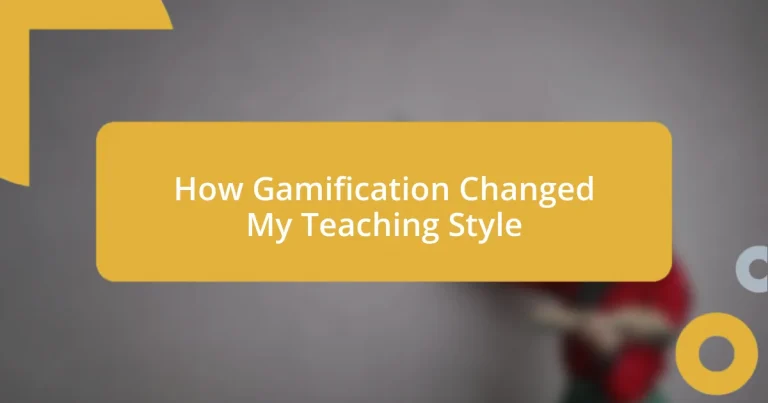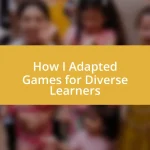Key takeaways:
- Gamification transforms traditional learning into an engaging and dynamic experience, motivating students through elements like rewards and community goals.
- Incorporating game mechanics, such as leaderboards and challenges, fosters collaboration, boosts participation, and adapts to diverse learning styles.
- Real-life examples showcase how gamification unlocks students’ hidden talents, enhances creativity, and encourages a deeper connection to learning across various subjects.
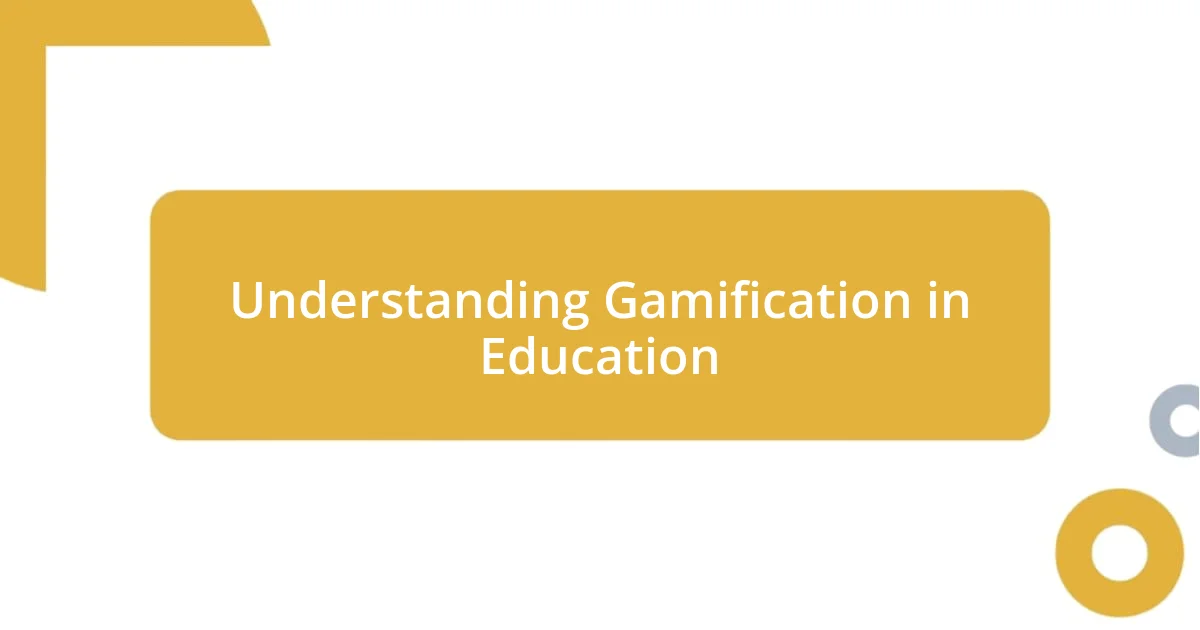
Understanding Gamification in Education
Gamification in education is more than just adding points or badges to assignments; it’s about transforming the learning experience into a dynamic and motivating journey. I remember the first time I introduced game elements into my classroom. The excitement in my students’ faces was palpable—suddenly, even the most mundane tasks felt like part of a grand adventure. Doesn’t it make you wonder how a simple shift in perspective can ignite such enthusiasm?
At its core, gamification taps into our innate desire for achievement and recognition. I’ve seen students who once hesitated to participate now eagerly contribute, driven not just by grades but by the thrill of earning rewards. This shift made me question, how can we harness that same energy to motivate even those who are typically disengaged? The answer lies in creating a sense of community and shared goals, where each student feels valued in their contributions to the classroom’s collective success.
In my experience, effective gamification requires a thoughtful balance. It’s not about making everything a game; rather, it’s about integrating playful elements that support educational principles. I’ve found that when I carefully align game mechanics with learning outcomes, the result isn’t just engagement—it’s a deeper, more meaningful understanding of the content. How often do we get a chance to make learning so personally enriching? That’s the beauty of gamification: it’s a gateway to not just knowledge, but connection and growth.
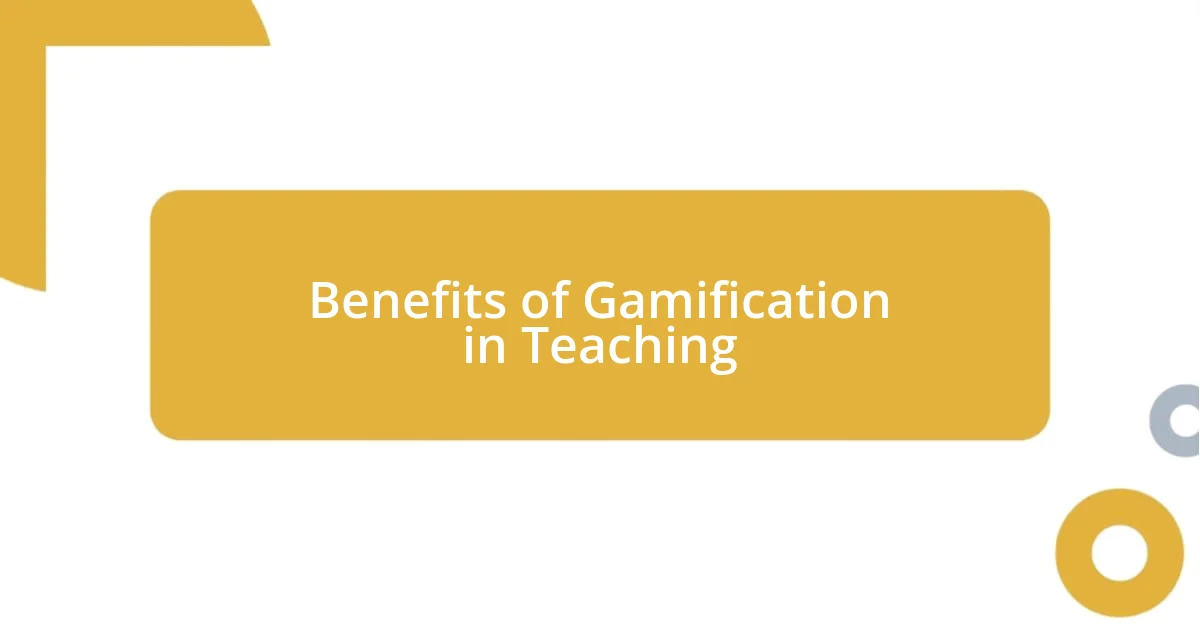
Benefits of Gamification in Teaching
Gamification has drastically transformed my teaching approach by making learning more interactive and enjoyable. For instance, I once introduced a point-based system during a history project. I noticed that students who typically shied away from discussions began to actively engage, striving not just to complete the assignment but to climb the leaderboard. It was rewarding to witness this shift and see the enthusiasm spread among the classmates like wildfire.
Incorporating game mechanics has also fostered a sense of collaboration among my students. I remember implementing team challenges in math, where groups raced to solve problems. This created an atmosphere of healthy competition, encouraging students to work together and support each other. The laughter and camaraderie in the room were infectious, turning what could have been a stressful review session into a joyous learning experience.
The adaptability of gamification makes it a powerful tool in addressing diverse learning styles. Students who struggle with traditional assessments often thrive with game elements. For example, visual learners became more engaged when we integrated digital storytelling into our lessons. I saw how they could retell complex concepts through animated presentations, which empowered them to showcase their creativity while deepening their understanding. It’s moments like these that reaffirm the profound impact gamification has on our classrooms.
| Benefit | Example |
|---|---|
| Enhanced Engagement | Using a point-based system increases student participation. |
| Collaboration | Team challenges foster cooperative learning. |
| Adaptability | Integrating digital storytelling caters to visual learners. |
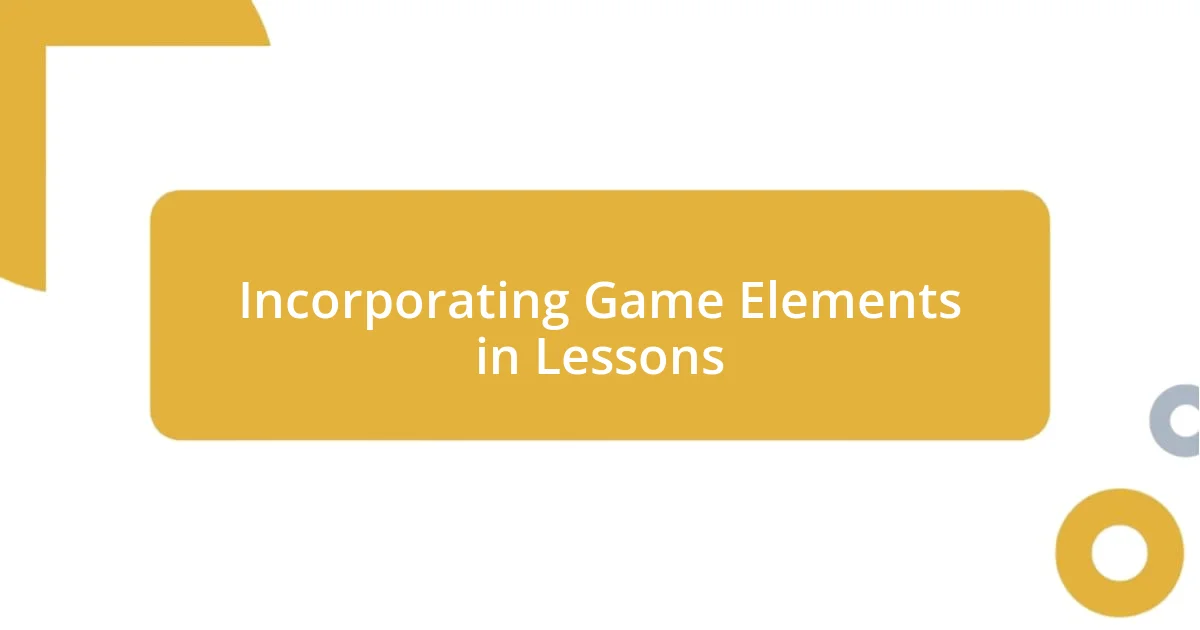
Incorporating Game Elements in Lessons
Incorporating game elements into my lessons has opened up a whole new world of engagement. I vividly recall the first time I transformed a vocabulary quiz into a scavenger hunt. Suddenly, students were not just memorizing words; they were racing around the classroom, searching for clues and collaborating with their peers to complete the challenge. That buzz of excitement was contagious, sparking a genuine enthusiasm for learning that I had longed to witness.
Here are some game elements I’ve effectively integrated into my lessons:
- Leaderboards: I created a digital scoreboard for collaboration in group projects, fostering a sense of friendly competition.
- Badges: Students earn badges for completing specific challenges, which they eagerly display on our classroom wall.
- Storytelling: I turn lessons into narratives where students embark on quests, making content interconnected and relatable.
For me, the magic lies in how these small changes in my teaching style can lead to such vibrant interactions. One student told me how he felt like a superhero working on his math assignments when we incorporated themed challenges. Hearing that not only melted my heart but also drove home the power of play in learning. It’s in these moments that I realize how gamification brings out the best in my students.
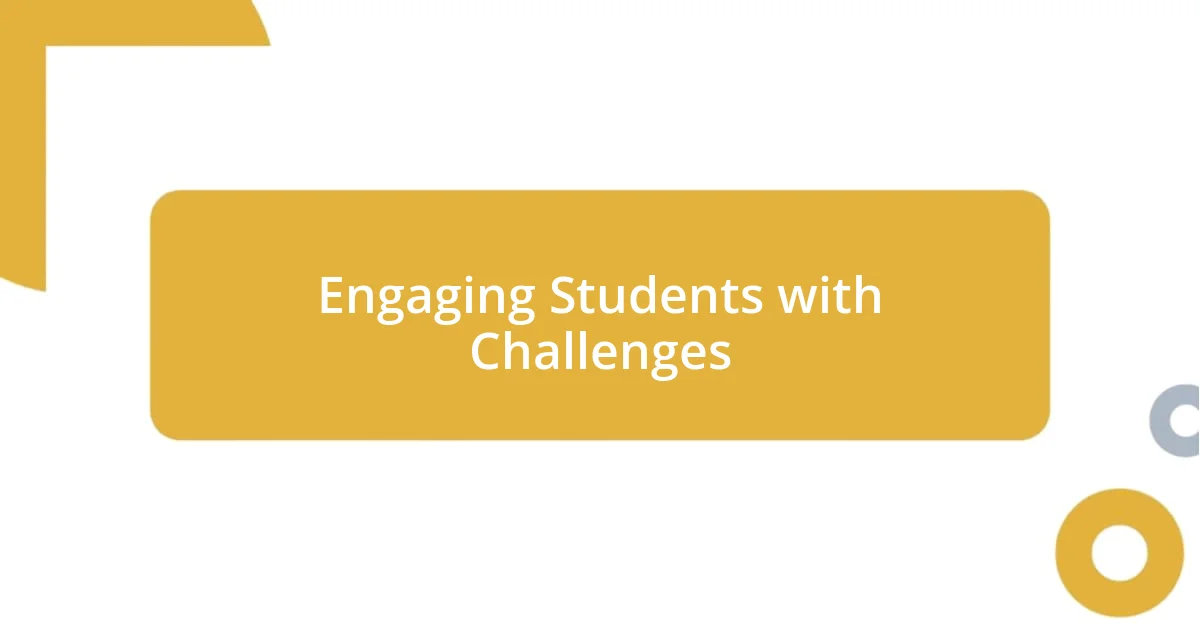
Engaging Students with Challenges
Engaging students with challenges has been a game changer in my classroom. I recall struggling with a particularly disinterested group when I decided to implement a classroom quest. The students had to solve math puzzles to unlock the next part of their story. I was amazed at how quickly their faces lit up; they weren’t just solving problems anymore; they were adventurers on a mission. That excitement transformed the atmosphere—no longer was it a mundane math lesson, but a thrilling quest that demanded their full attention.
I’ve always believed that challenges need not be intimidating. In one instance, I introduced a series of escalating mini-challenges during a revision week. My students started with easy tasks and gradually built their confidence, showcasing their mastery of the subject matter. I noticed that those who typically hesitated to participate began volunteering answers and even helping their classmates. It was heartwarming to see this newfound confidence blossom, and it made me reflect—how often do we underestimate the power of bite-sized challenges in fostering engagement?
One of my most memorable experiences involved a science experiment turned competition. Students had to construct the tallest free-standing tower using just spaghetti and marshmallows. The room buzzed with strategic discussions and bursts of laughter as teams competed against each other. I particularly remember a shy student who rarely spoke up, but that day, his ideas flowed as he took charge of his group. Watching him thrive in a competitive, yet supportive environment made me realize just how powerful engaging students with challenges can be. It leads not only to deeper learning but also to personal growth, pushing them beyond their perceived limits.
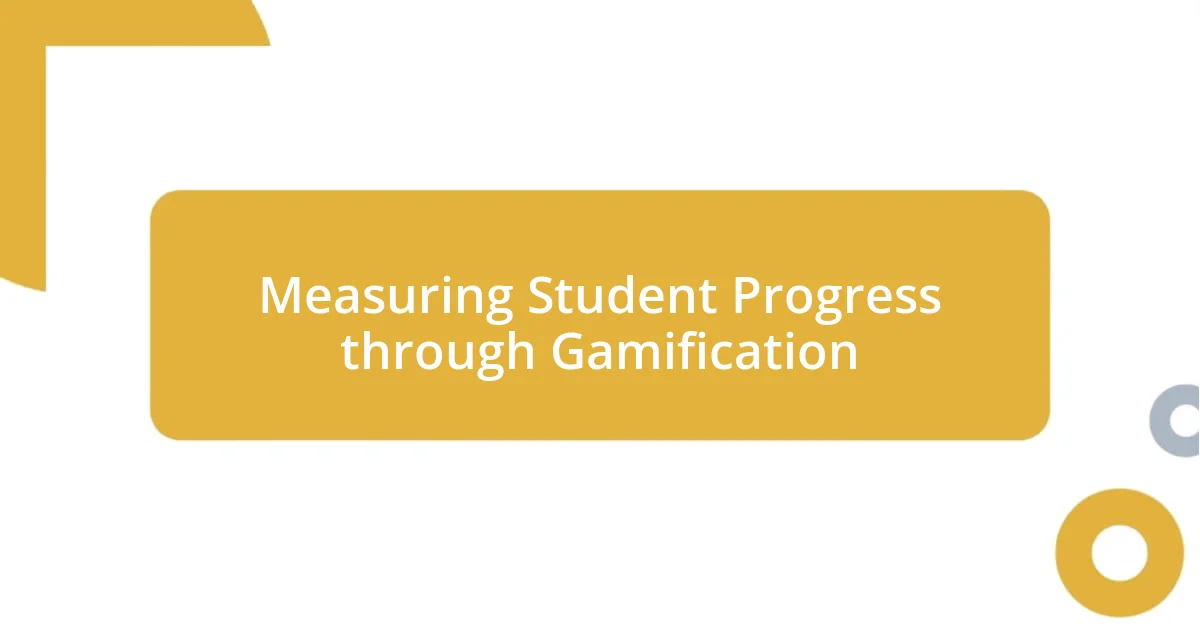
Measuring Student Progress through Gamification
Measuring student progress through gamification has dramatically reshaped my approach to assessments. One of the most effective tools I’ve used is the concept of leveling up. I set specific learning milestones that students must achieve to move up levels, much like in a video game. Watching them strive to reach the next level, see their effort paying off, and their excitement is electrifying. It’s like being a coach, cheering them on as they discover their capabilities.
I track their progress using visual aids like progress bars and graphs, which I display prominently in the classroom. I recall a moment when a student who had been struggling with reading fluency finally saw his progress bar inching closer to completion. His eyes widened with realization; it was a lightbulb moment for him. Suddenly, he understood that each small step forward contributed to his overall success. This tangible representation makes the abstract idea of progress concrete and encourages them to own their learning journeys.
Incorporating feedback loops has also enriched the experience immensely. I often conduct quick, game-like quizzes where instant feedback is given, allowing students to adjust their strategies on the fly. I vividly remember the day a student, usually reserved, raised his hand after a quiz and excitedly exclaimed, “I didn’t know I could improve that fast!” That moment solidified for me how gamification transforms assessments into opportunities for growth—encouraging learners to embrace challenges rather than shy away from them. Isn’t it incredible how shifting our perspective on progress can inspire students to become more engaged and motivated?
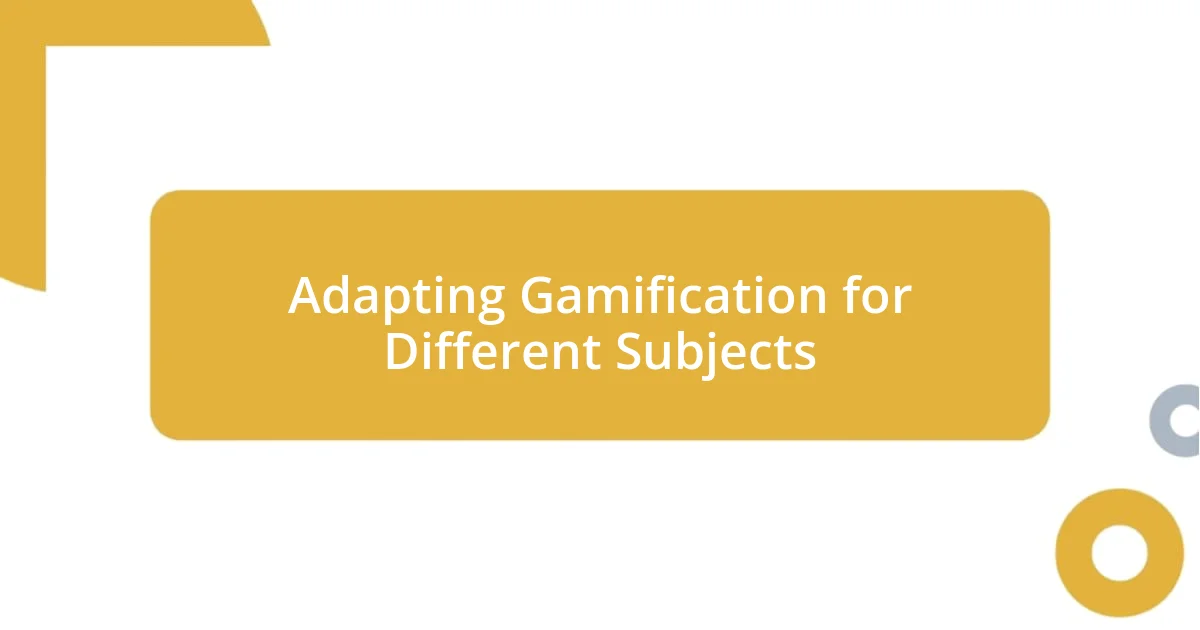
Adapting Gamification for Different Subjects
In adapting gamification across different subjects, I’ve found that the key lies in understanding each subject’s unique characteristics. For instance, in humanities classes, I transformed debates into role-playing games where students embodied historical figures. Watching them dive into their roles added authenticity to discussions, leading to deeper engagement. I often wondered, how can such immersion make history feel more relevant to students? By stepping into the shoes of those from the past, they truly connected the dots.
In math, I’ve designed a treasure hunt that requires students to solve equations to find clues hidden around the classroom. This not only reinforced their problem-solving skills but also turned abstract concepts into an exciting adventure. I still chuckle recalling a day when a student exclaimed, “I didn’t know math could be this fun!” This made me realize that when we adapt gamification to fit the subject, we can change perceptions about learning altogether.
Even in art classes, I’ve implemented gamification by introducing challenges like creating pieces under time constraints or with specific themes. This not only nurtured creativity but fostered a sense of friendly competition. I remember the buzz in the room as ideas flowed, with students cheering each other on—it transformed our space into a vibrant studio. Isn’t it fascinating how adapting gamification to various subjects can create a more dynamic learning environment?
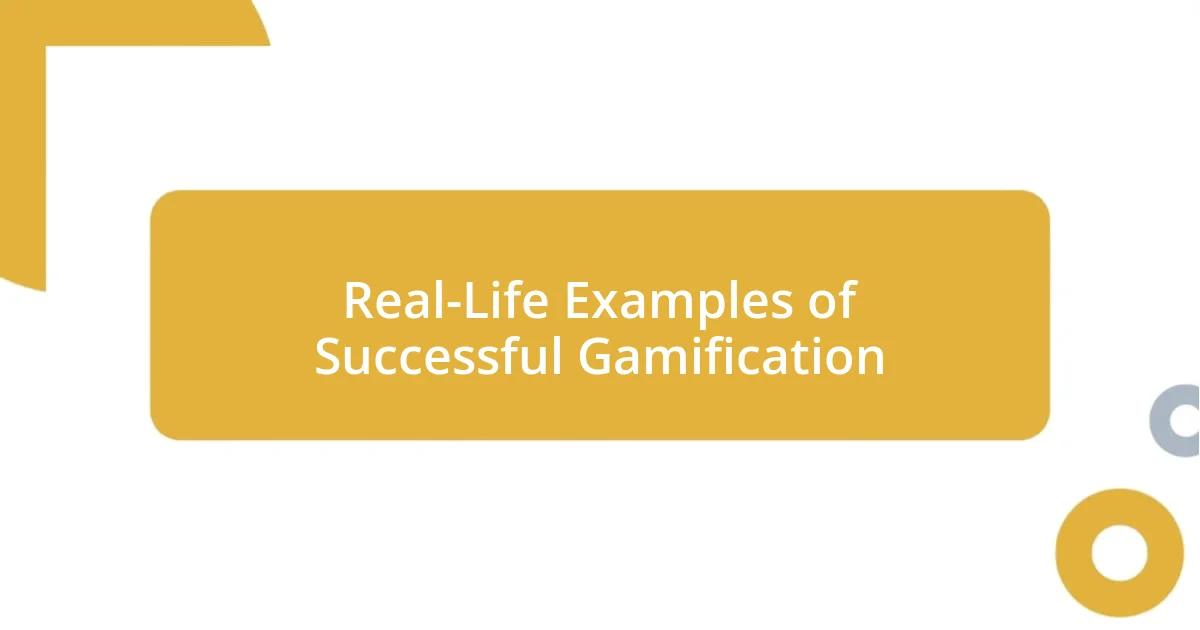
Real-Life Examples of Successful Gamification
I once participated in a gamified language arts project that blew my mind. We created a “writing quest” where students earned badges for completing writing tasks, like crafting persuasive essays or composing poetry. One day, a usually quiet student approached me after class, beaming with pride after earning her first badge. “I can’t believe I wrote that story!” she said, and in that moment, I realized how much gamification can unlock hidden talents and boost self-esteem.
Another memorable example comes from a science class where we turned group projects into competitions. I divided the class into teams, challenging them to design eco-friendly inventions. What amazed me was the creativity that flowed—not just from the top students, but from everyone. At the end of the project, each group presented their ideas with infectious enthusiasm. I could almost feel the electric atmosphere in the room as they cheered for each other. It’s moments like these that make me wonder, how many opportunities to shine do we miss without gamification?
I also remember a math unit where students tackled geometry through a game called “Design Your Dream House.” They had to apply geometric principles to create their ideal floor plans, earning points for precision and creativity. One student, who normally dreaded math, spent hours sketching his design. When he finally presented it to the class, his excitement was contagious. “I didn’t just do math—I made something cool!” he exclaimed. Seeing that kind of passion fuels my belief that when students engage in gamified learning, they don’t just learn—they thrive. How empowering is it to watch students discover joy in learning?












